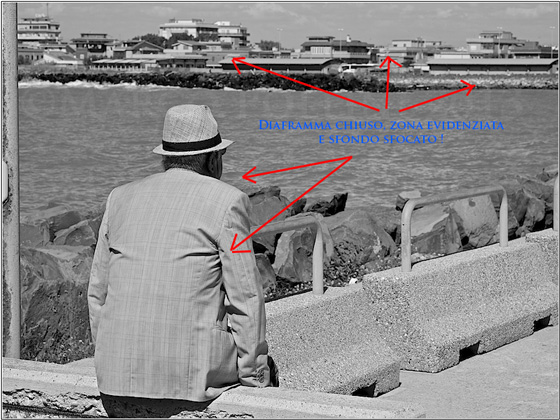Sommario
L'obiettivo - l'otturatore - il diaframma - indici di esposizione - mirino fotocamera - l'esposimetro - il telemetro - la pellicola - regola per una esposizione perfetta - La distanza iperfocale - La messa a fuoco all'infinito - Regole per utilizzare l'esposimetro analogico - Soggetti in movimento - La pellicola pancromatica - Fotografia con teleobiettivi - Consigli per la fotografia a colori - Misura dell'esposizione
- ITA -
L'obiettivo fotografico è senz'altro uno dei componenti fondamentali della macchina fotografica, vediamo il perchè!
Ciò che fa incanalare la luce verso la pellicola per poi impressionarla è proprio l'obiettivo, di base esso è composto da una lente biconvessa ma ai giorni d'oggi correzioni e nuove tecnologie hanno permesso all'utente finale di godere di un prodotto spesso o per lo più esente da gravi problemi di deformazione, chiamati comunemente "aberrazioni".
![]()
(Image Wikipedia)
Una delle caratteristiche più importanti dell'obiettivo è la "luminosità".
Essa è tanto maggiore quanto più è elevata la quantità di luce che riesce ad entrare all'interno. Ciò dipende dalla sua apertura e dalla sua "lunghezza focale", quest'ultima indicata con la lettera " f ".
E' possibile leggere questo valore direttamente all'esterno dello strumento, in quanto esso viene indicato proprio su una delle ghiere di regolazione.
La lunghezza focale è data dalla distanza tra il centro ottico dell'obiettivo ed il piano della pellicola, una volta regolato l'obiettivo su infinito.
Ciò ci porta ad un'altro problema di cui si deve necessariamente avere nozione se si vuole fotografare al meglio!
Quanto più la lunghezza focale è maggiore e tanto più piccolo sarà l'angolo visivo dell'obiettivo.

(Image Wikipedia)
Questo è molto evidente se si è in grado di utilizzare diverse tipologie di strumenti ed in particolare:
- Focale media, cioè obiettivi standard tipicamente 50 mm o 35 mm vicini all'angolo visivo dell'occhio umano.
- Lunga focale, tutti quelli i quali permetto di avvicinare molto il soggetto con angolo visivo molto ridotto, detti anche teleobiettivi.
- Corta focale, tipicamente i "grandangolari", utilizzati per ottenere un'angolo visivo il più ampio possibile.
Un'altra caratteristica importante è il "fuoco":
Ogni volta che il nostro soggetto si avvicina o si allontana il punto di fuoco cambia, ciò fa visualizzare l'immagine risultante uno scatto in maniera sfocata e non più nitida!
Qui entra in gioco il "focheggiatore", il quale prende posto in una delle ghiere dell'obiettivo e che permette di regolare, spostando avanti o in dietro il primo gruppo di lenti, la nitidezza del soggetto in questione.
Un'ultimo aspetto da capire è la "profondità di campo", già ampiamente trattata nella nostra sezione dedicata alla fotografia digitale.
Essa è maggiore o minore a seconda della variazione dei seguenti fattori:
- lunghezza focale
- apertura del diaframma
- distanza dal soggetto
Come vedremo successivamente essa è essenzialmente regolata dal diaframma ed in particolare:
Maggiormante il diaframma è chiuso e più andremo ad evidenziare una zona nella nostra immagine in cui sarà maggiore la nitidezza. Al contrario quanto più sarà aperto, l'intera immagine risulterà a fuoco ma allo stesso tempo molto più piatta e senza alcun riferimento preciso!
Approfondiremo questo aspetto nel capitolo dedicato al "diaframma".

(Copyright by Marco Pollini, all rights reserved 2013)
- ENG -
The camera lens is undoubtedly one of the fundamental components of the camera, we see why!
What makes channeling the light towards the film to impress then it is precisely the objective, of base it is composed of a biconvex lens but nowadays fixes and new technologies have allowed the end user to enjoy a product often or mostly free from serious problems of deformation, commonly called "aberrations".
One of the most important objective is the "brightness".
It is greater the higher the amount of light that is able to enter inside. This depends on its openness and its "focal length", the latter indicated by the letter "f".
E 'can read this value directly to the outside of the instrument, as it is indicated precisely on one of the adjusting rings.
The focal length is the distance between the optical center of the lens and the film plane, once adjusted the lens to infinity.
This brings us to another problem which must necessarily have knowledge if you want to photograph the best!
The longer the focal length is greater and the smaller is the viewing angle of the lens.
This is very evident if one is able to use different types of instruments and in particular:
- Focal media, that standard lenses typically 50 mm or 35 mm closer to the viewing angle of the human eye.
- Long Focal, all those who dare to approach the subject with very low viewing angle, also called telephoto lenses.
- Short focal, typically the "wide-angle", used to obtain an angle of view as large as possible.
Another important feature is the "fire":
Every time our subject is approaching or leaving the focus point changes, it does display the image resulting in a blurry one click and sharper!
Here comes the "focuser", which takes place in one of the rings of the lens and allows you to adjust by moving forward or behind the first lens group, the sharpness of the subject in question.
A final aspect to understand is the "depth of field", already widely discussed in our section dedicated to digital photography.
It is more or less depending on the variation of the following factors:
- Focal length
- Aperture
- Distance from the subject
As we will see later it is essentially governed by the diaphragm and in particular:
Maggiormante the aperture is closed and more we're going to highlight an area in which our image will be greater sharpness. On the contrary, the more will be opened and the entire image will be in focus but at the same time much more flat and without any precise reference!
Deepen this aspect in the chapter on "diaphragm".









